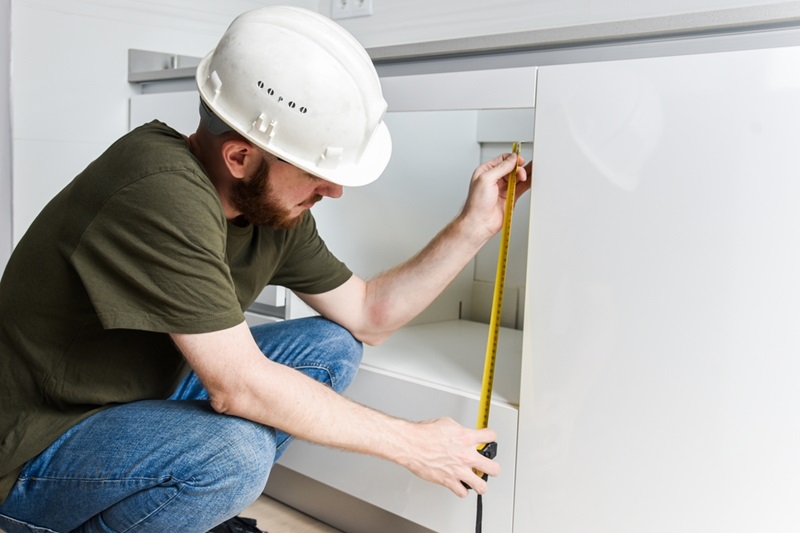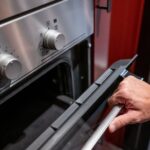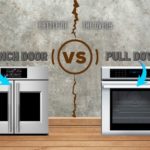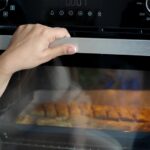When looking for a new oven for your kitchen, you want to know that your oven will fit. Both in design terms and just fit in general really!
Finding the right oven for your kitchen isn’t difficult, but there are a few things that can cause headaches. What if you find the perfect oven for the design of your kitchen, only to find out that it is too big or small for the gap you have?
Well, we can’t help with choosing the perfect oven for your kitchen in a design sense, at least, not in this article. However, we can help you measure up for your new oven and ensure that it will fit perfectly, so let’s do just that now, shall we?
What Is the Standard Size for an Oven?
- Width: A standard oven is slightly less than 60 cm in width. However, there are ovens available that start from 50 cm and go up to 60 cm. We are talking about built-in ovens here by the way. An oven that is labelled as being 60 cm wide will fit in a 60 cm gap, because the oven will actually be slightly less than 60 cm.
- Depth: Depth wise, an oven can be anywhere from 55-65cm.
- Height: When it comes to the height of an oven, a single oven will be about 60cm. Double ovens can be 70-90cm. Built-under ovens can be anywhere from 60-75cm meaning they will fit under any standard worktop. Compact ovens will be about 45cm tall, about the same height as a large microwave.
You might not think that a few centimetres here and there would make much of a difference. Well, check out the section below where I go into litres and available cooking space, it might surprise you at how much just 5 cm off of one of these measurements can do.
Standard Oven Sizes in Litres
The standard oven sizes in litres in the UK vary a lot. This is where you have to do your research.
Even buying an oven with the same dimensions as your old one doesn’t mean that you get the same cooking space (often called the cavity).
For example, a single oven can have an interior capacity of between 40 and 115 litres. A built-in double oven (with a grill above the large oven) can have an internal capacity of 85-135 litres. However, the bottom oven will range from 50 to 75 litres and the top 35-60 litres.
Of course, the litres that an oven can hold doesn’t tell you everything you need to know about the available cooking space. You still need to find out how many shelves an oven has, which is typically between 2-3 shelves.
An oven with 2-3 shelves can comfortably cook for large groups. A single oven can normally have one to four shelves and are ordinarily fine for entertaining too.
Standard Dimensions of Different Oven Types
I am about to give the standard dimensions of as many built-in and built-under ovens as I can.
However, as I do, notice the theme. All of these ovens are designed to go into a housing unit. This is the heat shroud thingy I mentioned above.
As I said, a few manufacturers don’t use this housing, but most do. So, if you are really stuck on which oven to buy, an oven from the same manufacturer will likely fit into the housing you already have, as long it is the same type of oven. For example:
- Built-in:
- Single ovens: Fit in a 60 cm high x 60 cm wide x 60 cm deep housing unit
- Double ovens: Fit into a 90 cm high x 60 cm wide x 60 cm deep unit
- Compact ovens: Fit into a 45 cm high x 60 cm wide x 60 cm deep unit
- Built-under:
- Fit into a 90 cm high x 60 cm wide x 60 cm deep unit. Standard UK countertops are 90 cm high, so they are designed to fit under this.

How do I measure the Size of My Oven?
If you are replacing a built-in or built-under oven with the same type of oven, use your existing oven to measure for the new one.
Now, these types of ovens are not easy to install, so don’t expect to be able to pull it out of the hole and grab your measuring tape. Instead, try and find the user manual you said you’d keep safe when you bought the oven.
If you can’t find the user manual of your oven, look up that exact model online. Make sure it is the correct model, though. Often built-in ovens can have very similar model numbers.
Even if the company doesn’t make your oven anymore, you can still find the user manual online typically. You can then look at all of the relevant dimensions you need and compare them to the new oven you are interested in.
Are All Ovens the Same Width?
No, as I stated in the section above, the width of an oven can range from 50-60 cm. However, a lot of oven manufacturers install ovens into what is basically a heat shroud that is a pretty standard size.
An oven that isn’t exactly the same width as your previous one could still work in the space. It’s always best to get an oven that is the same size as your existing one, but if you have already got a new oven that you didn’t realise was smaller, there is a chance that hope is not lost.
Conclusion
Basically, try to relax about your new oven. As long as you are buying the same type of oven as your existing one, a single oven, for example, it will fit into the gap you have no problem at all.
If you are really unsure, find the user manual (in your draw of doom or online!) and find out the exact dimensions of your oven.
I hope this look at the measurements of ovens has been helpful and has calmed you down about the situation. For more advice on ovens, please explore our website further. Happy cooking!

Scott is a writer and a passionate home chef. His passion for cooking began when he was 10 years old. Scott has been writing professionally for over five years now and loves to combine his passion for cooking with his day job.







